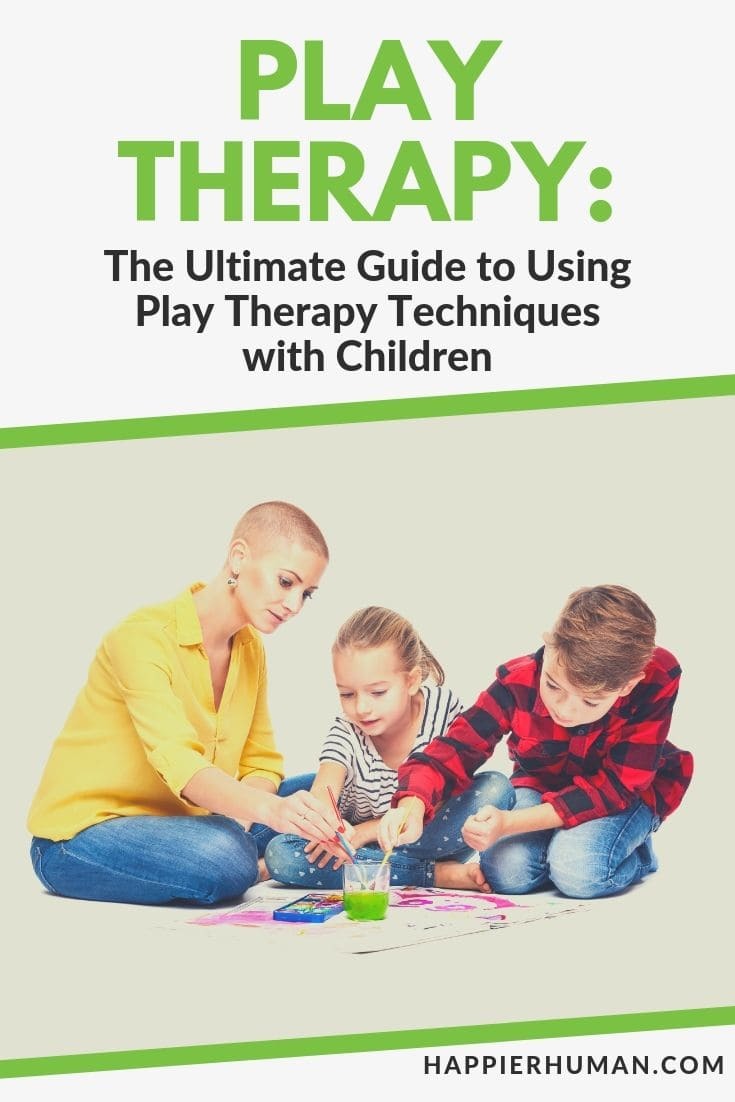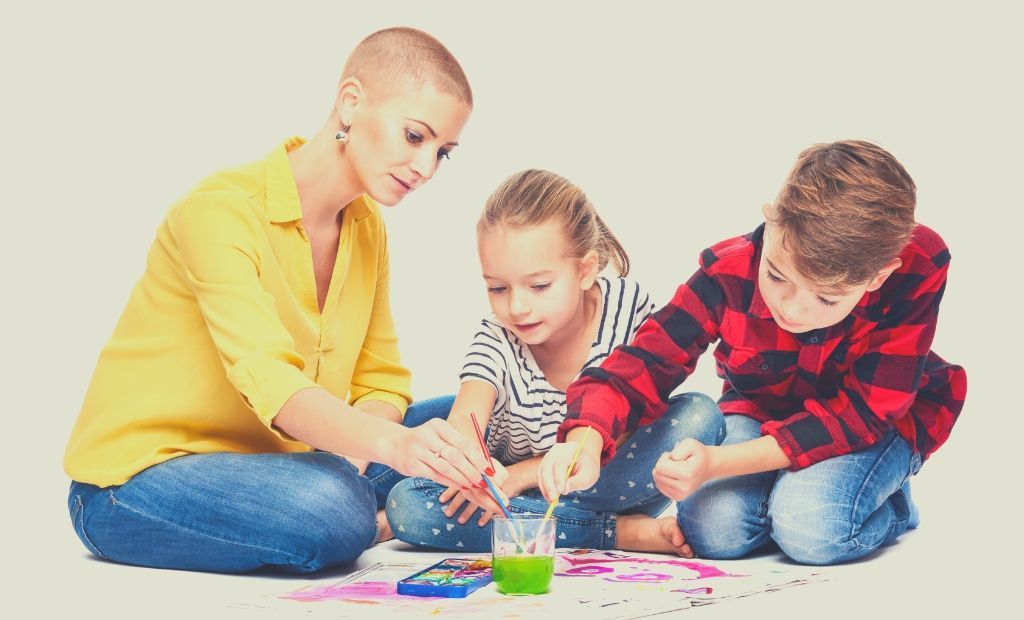Playfulness is a universal human characteristic that brings immense joy and satisfaction. People of all ages and cultural backgrounds engage in playful activities that stimulate them cognitively, emotionally, and socially.
From an evolutionary perspective, play cultivates learning and helps us explore the world in a fun and engaging manner. In other words, it’s a low-cost alternative to other learning activities that require sustained effort.
But did you know that play can also be a therapeutic act? For decades, experts in child development have been using play therapy to gain insights into children’s behavior.
But the little ones aren’t the only eligible candidates for play therapy. In fact, this approach has proven quite effective for teenagers and adults as well.
Although it might seem a bit unconventional, grown-ups can learn a lot about themselves when they’re encouraged to let go of their adult self and embrace their inner child.
So, how exactly does play therapy work, and why should we embrace playfulness?
What is Play Therapy?
In a nutshell, play therapy is an alternative approach to mental health and wellbeing that relies on fun activities which can lead to valuable insights about ourselves.
With the help of play therapy, children, teenagers, and even adults can learn to cope with difficult emotions, acquire valuable life skills, and cultivate healthy social interactions.
Initially, this therapeutic approach was designed to help children express themselves freely and creatively. That allows therapists to observe children’s behaviors and emotions.
For a 10-year-old who’s been through a traumatic event, using words to describe what he/she has witnessed might be too painful.
On top of that, children don’t always understand what they’re going through (emotionally). That means they can’t put in words the emotional distress that’s causing adverse personal issues.
And this is where play therapy proves extremely useful, as it allows professionals to get a better sense of what a child might be going through.
In essence, the purpose of play therapy is to help children overcome behavioral and emotional difficulties that interfere with their normal functioning.
Furthermore, therapists who use this approach place a strong emphasis on improving communication and understanding between the child and the parents.
Other therapeutic goals include managing anxiety and frustration, cultivating strong social skills, improving verbal expression, and so on.
When it comes to using play for therapeutic purposes, some professionals adopt a nondirective approach while others prefer a more directive stance.
Nondirective play therapy involves creating the optimal therapeutic conditions for a child to express freely. The therapist’s involvement is minimal, and children can find their own ways to resolve personal issues.
Directive play therapy relies on the active involvement of the therapist who coordinates the process. As a result, children can achieve happiness and wellbeing faster than they would in nondirective therapy.
Is Play Therapy Evidence-Based?
Although many of the original theories that have shaped play therapy are outdated, this approach relies on a robust set of empirical evidence.
In recent years, researchers have managed to transform play therapy into a valid and effective approach to children’s health and happiness.
But to understand why play therapy can be crucial for a child’s psychosocial development, we need to look at the basic biology of the human brain.
Children are born with billions of neurons that make up their central nervous system. But a child’s nervous system lacks the complex neural connections specific to adolescent or adult brains.
And that’s why children need a wide diversity of fun and engaging activities that stimulate neural interconnectivity, allowing them to develop the skills they need to navigate the environment.
In other words, play motivates children to engage in productive activities that build motor, cognitive, emotional, and social skills. With the help of these crucial skills, children can interact with the world healthily and constructively.
In terms of children’s mental health and wellbeing, a recent meta-analysis published in The Journal of Counseling & Development revealed that play therapy is a viable treatment option for children who struggle with emotional or behavioral issues.
Furthermore, experts believe posttraumatic play can be an excellent coping tool for children who were exposed to disasters and collective traumatic events. It’s also a viable assessment and intervention tool for child victims of sexual abuse.
Long story short, there’s a significant body of evidence suggesting that play therapy is a robust therapeutic approach for children who are facing difficulties in dealing with life’s unexpected turns.
Important Figures in Play Therapy
1. Anna Freud, an Austrian-British psychoanalyst, continued the legacy of her father (Sigmund Freud) but with a strong emphasis on child development. She believed play is an essential part of the therapeutic process, as it builds a positive relationship between the therapist and child.
2. Melanie Klein, another Austrian-British psychoanalyst, has brought significant contributions to developmental psychology.
For her, play therapy was the path to a child’s unconscious and a fun activity that motivates children to participate in the therapeutic process.
3. Virginia Axline is one of the pioneers of nondirective play therapy. Many of the techniques and principles that play therapists use today are based on her works.
Using Carl Rogers’ person-centered approach, Virginia Axline was able to create a relatively new therapeutic approach that prioritizes the child’s needs and desires.
Can Play Therapy Help Your Troubled Child?

Play therapy is a form of psychotherapy that encourages children to express freely, manifest their entire emotional spectrum, and address their problems through fun and engaging activities.
Under the supervision and guidance of a professional, children learn to give voice to their needs and desires in a healthy manner.
At first glance, this entire process seems like a fun interaction between the therapist and the child. And that’s precisely how the whole process should feel like.
However, children are encouraged to play in a structured and safe environment, with games and toys provided by the therapist.
The underlying purpose is to observe the child’s behavior, emotions, and language in other to understand his thoughts, feelings, and potential difficulties that might interfere with his day-to-day life.
When problems emerge, play activities allow therapists to help kids understand and overcome whatever obstacles are preventing them from enjoying a happy childhood.
Common Problems Addressed Through Play Therapy
Experts believe play therapy is the ideal approach for a wide range of problems that today’s children are facing. From anxiety and depression to trauma and anger, this therapeutic approach assists children in regaining emotional balance and wellbeing.
1. Anxiety is one of the most common problems that children are facing these days. In broad lines, this condition is characterized by restlessness, lack of focus, poor academic performance, constant worrying, and even panic attacks.
According to the Anxiety and Depression Association of America, nearly 25% of children between 13 and 18 years old are diagnosed with a form of anxiety disorder.
2. Depression is a mood disorder that can have a profoundly negative impact on children’s personal, social, and academic success. This condition robs you of those little moments of joy and happiness that make life worth living.
Worldwide, there are approximately 322 million people living with depression. In the US, only 40% of all the children and teens with depression receive proper treatment.
3. ADHD is a neurodevelopmental disorder that comes with a wide array of unpleasant symptoms like impulsiveness, lack of focus, hyperactivity, and restlessness.
As you can imagine, children who struggle with ADHD can have a hard time keeping up with school activities and maintaining healthy social interactions.
This can result in a lot of frustration and disappointment which, in turn, affects their overall sense of happiness and wellbeing.
4. Autism spectrum disorders are a class of neurobiological conditions that begin to manifest around the age of 2 or 3 years old.
Children with autism tend to engage in repetitive behaviors, have trouble maintaining eye contact, and often lack vital communications skills.
5. Posttraumatic stress occurs as a result of witnessing traumatic events such as domestic violence, car accidents, or natural disasters. Since children lack the coping skills that would allow them to overcome trauma, they often end up dealing with flashbacks, nightmares, panic attacks, and social isolation.
All these adverse effects can leave a serious mark on their personal, emotional, and social development.
6. Anger issues are often the result of dysfunctional parenting styles. Children raised in households where physical or verbal violence is part of everyday life learn to express anger in destructive and unhealthy ways.
But anger can be the result of numerous unpleasant life events that children don’t know how to cope with. So, it’s up to the therapist to use play as a therapeutic tool that unveils the source of anger and heals emotional wounds.
Since children and teens are among the most vulnerable groups in terms of mental health conditions, counselors and therapists need to find creative ways to forge a strong therapeutic alliance and cultivate happiness and wellbeing through fun activities.
Sometimes, even adults need a fun alternative to ‘talk’ therapy. And that’s when play activities can be the ideal therapeutic tool for those of us who might find it challenging to express painful emotions directly.
Long story short, play therapy is a viable treatment option for many of the emotional and behavioral problems that children, teens, and adults are dealing with. But can playfulness help us achieve a happier life?
Play Therapy and Happiness: Is There a Link?

It’s hard to put a finger on what happiness truly is. For some, happiness is a process; a lifelong journey of self-exploration, self-discovery, and self-growth.
Others find happiness in small moments of joy like playing hide and seek with their little ones or being part of an amateur football team.
Although happiness is a universal human trait, each of us achieves this mental state in different ways. But if there’s something we can all agree on is that happiness and play go hand in hand.
Just think about the emotions that you experience when you allow yourself to act playfully and enjoy fun activities. Think about those moments when you put aside adult responsibilities and give yourself the freedom to act ‘childish’ and goofy.
For children, the link between happiness, wellbeing, and play is unquestionable. As one scientific paper highlights, “participation in play is imperative for child well-being, since play is a fundamental occupation in early childhood in most cultures across the world.”
In a way, we could argue that play activities cultivate valuable moments of happiness that can have a significant impact on our overall sense of wellbeing. Perhaps happiness, like many other life goals that we pursue, requires a bit of effort and dedication on our part.
But play isn’t just a tool through which we cultivate activities that generate happiness. As Plato once said:
“You can discover more about a person in an hour of play than in a year of conversation.”
In other words, play facilitates self-discovery, allowing us to show ourselves (and others) who we are. It is the bond we share with our inner child – the one who knows what pure happiness is.
Since play can be both an individual and group activity, it’s important to share this experience with the people we love and care about. In fact, play doesn’t just cultivate happiness within us but also helps others achieve the same mental state.
It’s kind of like a healthy exchange of positive emotions where each person gives and receives joy.
For example, a study published in the Korean Journal of Childcare and Education revealed that the quality of parent-child play has a positive effect on children’s overall sense of happiness.
Long story short, playfulness is a universal human trait that helps us discover the world, gain a better understanding of ourselves, and cultivate lasting happiness.
What Happens During a Play Therapy Session?
According to The Association for Play Therapy (APT), play therapy represents “the systematic use of a theoretical model to establish an interpersonal process wherein trained play therapists use the therapeutic powers of play to help clients prevent or resolve psychosocial difficulties and achieve optimal growth and development.”
If you wish to consult a play therapist, make sure he/she is accredited by APT, since this organization is the only nationally recognized professional institution dedicated to conducting research and providing training courses in play therapy.
Even Adults Can Join!
As we reach adulthood, many of us lose sight of the things that made us happy when we were kids. We put aside the play activities that shaped our childhood and teenage years to make room for adult responsibilities.
Soon enough, we discover that all work and no play can have a profoundly negative impact on our overall sense of satisfaction and wellbeing.
We get tangled in tasks, bills, student loans, and mortgage payments – thinking this is what life is supposed to look like – while our inner child desperately needs a moment of freedom and playfulness.
And that’s when problems like stress, burnout, depression, and anxiety begin to affect the overall quality of our life.
In order to cultivate lasting happiness and prevent emotional problems from ruining our lives, we need to give ourselves the chance to act playful once in a while.
For adults, play therapy can be a moment of calm; an opportunity to blow off some steam and reconnect with the small things that make us genuinely happy.
And since adults might be having a hard time letting go of adult responsibilities and getting in the mood to act playful, it’s up to the therapist to create a safe and comfortable.
This helps clients ‘open up’ emotionally and engage in play activities that are designed to help them gain a better understanding of themselves and cope with whatever problems that might prevent them from achieving happiness.
But you don’t necessarily have to visit a therapist to harness the benefits of play. Aside from the techniques that allow licensed professionals to have a more targeted approach, there are plenty of other play activities that can have a surprisingly therapeutic effect.
And the best part is that you can perform these activities on your own or with a group of friends who are open to acting playful in order to create that positive energy that makes playfulness so unique.

5 Simple and Effective Play Therapy Techniques
Play therapy incorporates an entire arsenal of fun, therapeutic activities that help you achieve happiness and wellbeing.
So, what exactly can we do to cultivate a playful moment?
1. Music
Music is among the simplest, most accessible activities that can put you in a playful mood.
Listening to your favorite tunes is a great way to relieve stress and cultivate positive emotions that contribute to your overall sense of happiness.
From a therapeutic perspective, researchers believe music can improve sleep quality and speed up recovery for critically ill patients. Furthermore, music therapy groups can have a positive impact on adolescents’ mood.
Because of how accessible this activity is, some mental health professionals think music can integrate well in pediatric psychiatry units.
But music alone might not be enough to create that playful atmosphere that generates positivity and happiness. Maybe you can kick it up a notch by adding some moves.
2. Dancing
Dancing to your favorite beat is an excellent way to cultivate a playful attitude. The combination of movement and sound creates a pleasant rhythm that your mind and body get hooked on immediately.
If you think about it, dancing has been used as a therapeutic technique for thousands of years. Cultures from across the globe have been using this activity for rituals of fertility, healing, birth, and death.
“Dance, when you're broken open. Dance, if you've torn the bandage off. Dance in the middle of the fighting. Dance in your blood. Dance when you're perfectly free.” – Rumi
Whether you prefer to dance in the comfort of your home or at a club, surrounded by friends, give your body a chance to move freely. Forget about your worries and follow the music.
3. Creative Visualization
Creative visualization allows you to play with your imagination. You can build an entire mental picture based on a single desire or need that you wish to fulfill.
Imagination allows you to be whomever you choose to be. It’s a place of pure freedom, where anything is possible.
Playing with your imagination can help you cultivate positive emotions and envision a brighter future. This will not only boost happiness but also serve as motivation. In other words, visualizing a goal that you wish to achieve will mobilize internal resources that help you turn dreams into reality.
And even if you don’t have a specific goal to achieve, the mere act of letting your imagination ‘fly’ can bring you tons of joy and amazement.
Find a comfortable position, close your eyes, and let your mind wander. Refrain from any worry-filled thoughts that might prevent you from visualizing a positive scenario.
Play with your imagination and envision a happier version of yourself. One day, that image might become your reality. Even though visualization takes you on a fantastic journey, the positive emotions that you experience are real.
4. Storytelling
Just as visualization allows you to play with your imagination, storytelling is an activity that lets you play with words and stories.
In a way, storytelling is a lot like visualization, both activities relying on imagination. But unlike visualization – which takes place entirely in your imagination – storytelling allows you to write down positive scenarios and even present them in front of an audience.
Stories have the power to change perspectives, trigger positive emotions, and cultivate happiness. It’s about playing with different characters, situations, and events, in an attempt to create something that generates joy, amazement, admiration, gratitude, and excitement.
Start by choosing an emotion you want to elicit and build your story around it. Play with your imagination, create an exciting scenario, and put it down on paper.
5. Drawing
As you can see, most play activities involve imagination. And there are numerous ways in which we can express our originality and have some fun along the way.
If you wish to reconnect with your inner child and enjoy a moment of pure happiness, drawing is the perfect activity because it involves playing with colors, shapes, and textures.
Whether you’re into drawing or painting, the visuals that you create can fuel positive emotions and provide a healthy coping tool for all those worry-filled thoughts that are causing stress and anxiety.
Furthermore, studies indicate that drawing can help people process traumatic events in a healthy and safe manner.
If you feel like you don’t have enough imagination to engage in this fun activity, you can start with adult coloring books.
Final Thoughts on Play Therapy
If you want to cultivate lasting happiness, you need to embrace playfulness and allow yourself to act ‘childish’ once in a while.
Just because you’re an adult doesn’t mean you should focus entirely on tasks and responsibilities. Your inner child knows precisely what you need to achieve happiness.
He/she is the keeper of your passions and desires, so perhaps it would be wise to follow him/her, especially when you feel like you’re carrying the weight of the world on your shoulders.
And the best part is that there are hundreds of games, items, and activities which allow you to enjoy the benefits of play:
- Drawing
- Painting
- Dancing
- Ball play
- Board games
- Costume play
- Puppet play
- Pottery
- Communication games
- Telling jokes
- Hide-and-seek
- Magic tricks
- Play-Doh
- Water balloon fights
In a nutshell, any activity that involves lots of fun and doesn’t require sustained cognitive effort can bring out your playful side. And that’s how you cultivate a sense of happiness that contributes to a better and brighter life.
And if you're looking for more resources on helping you parent better, check out these blog posts:
- 32 Printable Kindness Coloring Pages for Children or Students
- 96 Parenting Affirmations for Tough Moments with Your Kids
- 29 Powerful Bible Verses About Parenting
Finally, if you want a simple way to reduce your stress and anxiety, then try writing these 35 mindfulness journaling prompts to live more in the present moment.


Alexander Draghici is a licensed Clinical Psychologist, CBT practitioner, and content writer for various mental health websites. His work focuses mainly on strategies designed to help people manage and prevent two of the most common emotional problems – anxiety and depression.

